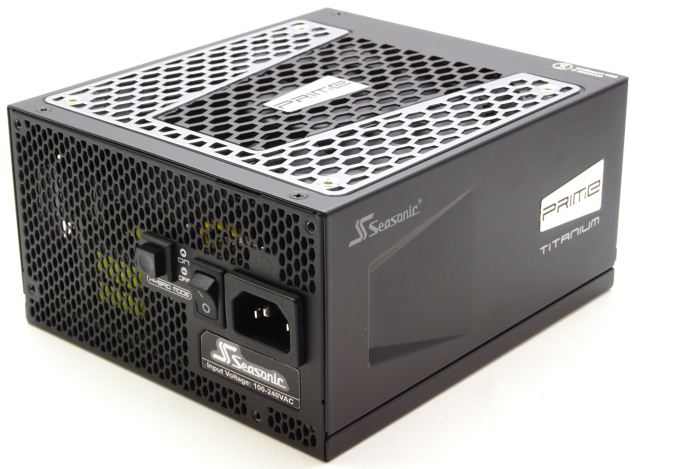The Seasonic PRIME Titanium PSU (650W, 750W, 850W) Review: Mythical Performance
by E. Fylladitakis on April 7, 2017 9:00 AM ESTConclusion
In this review we had a look at Seasonic’s latest top series, the PRIME Titanium 650W, 750W and 850W PSUs. They are not the most powerful models on the market designed for quad-GPU beats, but they are the technologically best units that Seasonic is currently offering to consumers.
It is slightly ironic to label these units as Seasonic’s “technological pinnacle”, because they are not using any of the latest “leading” topologies or technologies. As a matter of fact, their core topology is relatively common and simple; just a typical input bridge converter and APFC circuit, a resonant LLC full bridge on the primary with synchronous rectification on the secondary. It is a configuration that we have seen many times in the past, yet no other designer before Seasonic has ever reached such performance figures with it.
Seasonic made it easy for us to summarize the entirety of these units’ performance in just one word: mythical. The very high efficiency that easily broke the 80Plus Titanium certification requirements with 230V AC input was a small surprise at first, but surprise turned to shock when we began testing the units inside our hotbox. Not only the high ambient temperatures hardly shook the efficiency of the units, the power quality and voltage regulation figures were just incredible.

The AnandTech Recommended Award
For the Seasonic PRIME Titanium Series
Before testing these three units, we would not believe that such performance would be possible with a consumer-grade PC PSU.
In terms of quality, Seasonic did not hold back at all. We found only top-tier quality components in the PRIME Titanium PSUs, even down to the least significant elements of the design. The fact that the three units that we have tested display almost indistinguishable performance under the same load conditions suggests that there are no discrepancies due to component characteristics. Seasonic covers the PRIME Titanium units with a 12-year warranty, which is more than reassuring. The only small issue here is that the designer had to sacrifice some acoustics performance to ensure that the internal temperatures of the units will remain very low, even under very adverse operating conditions.
So perhaps the only real enemy of the new Seasonic PRIME Titanium series is their own retail price tag. Seasonic aims to be the best vendor with their OEM designs, and it all comes at a cost. With the 650W, 750W and 850W units retailing for $160, $175 and $200 respectively, many regular users will be satisfied with the performance of an “average” 80Plus Gold certified unit that will cost half as much, or even less. With all that being said, the retail price of these three units is not forbiddingly high - super high end PSUs reaching 1200W and above can come in at similar W/$.
But for these price tags, you get one of the most stunning PSU designs available today, combined with high efficiencies and a long warranty to back it up.












86 Comments
View All Comments
Jammrock - Friday, April 7, 2017 - link
I've had the 650W version since Oct 2016. It's powering an i7-6700K with a GTX 1080. Absolutely zero issues so far. It's quiet and efficient and solid. Can't recommend it enough. If the price tag fits within budget....My only gripe is the motherboard power cable. It's a split cable and kind of annoying to deal with. But then you only need to mess with it once per motherboard upgrade so really it's a very minor issue.
close - Friday, April 7, 2017 - link
Just out of curiosity, why didn't you go for the 750W if the price difference is just $5? Is it for efficiency reasons (less efficient than the 650W at your system's typical load)?Bullwinkle J Moose - Friday, April 7, 2017 - link
Low load efficiency was the reason I purchased a 350 Watt Seasonic SSR-350ST from newegg a few days ago instead of the SS-520GB or the SS-620GB @ B&H Photo for the same price when they were on sale last weekI wish you would cover power supply replacements for Monitors sometime
Had a standard 19 Volt LG power supply crap out last month and the only replacements I could find are basically CRAP
A T-Power replacement actually MELTED within 3 days and became non-functional before it had a chance to burn the house down
Other online stores for Monitor power supplies are complete scams selling more Chinese CRAP instead of the original equipment listed in their ads
I ended up using a VERY Old 120 Watt - 15 Volt Athena Laptop power supply with the T-Power Plug spliced to it's output
It works fine on 19 Volt LG's and cost about $30 around 10 years ago
I was a bit worried about EBay replacements for LG supplies but may need to try that route next time unless anyone knows where to buy "QUALITY" supplies with output current rated "above" what the stock LG's put out
Computer Power supplies are well covered at all the tech sites...
Monitor Supplies are never covered
Why is that?
Bullwinkle J Moose - Friday, April 7, 2017 - link
Modular cable outputs for 2 or 3 computer monitors on the back of these computer power supplies would be nice!I'd buy THAT!
alin - Friday, April 7, 2017 - link
Most laptop psu's are 18-20v. Plenty of them around :)Grimmm - Friday, April 7, 2017 - link
When I was overclocking a Korean IPS I bought a high power brick designed for medical applications on an online industrial parts catalog. Cost a bit, but works perfectly (after swapping the output connector)Jammrock - Tuesday, April 11, 2017 - link
@close - Two reasons. 1) At the time the 750W was more than a $5 difference. I purchased mine >6 months ago. 2) I try to size my PSUs to the load so they hit the peak of efficiency for the majority of my tasks. Granted, the difference is minimal for this particular 80Plus Titanium PSU, but old habits die hard.Sparkyman215 - Friday, April 7, 2017 - link
Wow. I've read a lot of your psu reviews, and I don't think you've used the words 'insanely good', 'unbelievable' - and of course 'mythical'. Even though the price is high, getting one of these and keeping it through upgrades for over a decade is probably a better deal than a lower end psu you have to replace several timesblahsaysblah - Friday, April 7, 2017 - link
It's pretty disheartening to think that they wont be modernizing either the cable layout/connectors or any other aspect of the PSU. It would be great if they could make things smaller/more direct. With the move to a single 12v rail, you would think they would move to single hot/ground per CPU/GPU connector. They have changed the insides a bit. Why there isnt some sort of data/status connector between PSU and MB... At very least to communicate PSU temps, but to add voltage,.. info, instead of all those sense cables.JasperJanssen - Saturday, April 8, 2017 - link
Moving to single wire bundles wouldn't gain you anything, and in fact loses you things. The reason there's 2 or 3 wires in those pcie bundles is current capability -- both for the connector and for the wires. So you still need the same amopunt of copper (actually, slightly more) to do that, if you move to having single wires instead of doubled. but those wires are going to be stiffer and more expensive. In other words, that's a bad idea.And re Status connectors -- while Seasonic could unilaterally add something custom, how many motherboard companies do you think would put a matching connector on? Also, the only thing that even *can* be monitored inside a PSU is the fan speed. That's why they occasionally had a fan speed wire coming out, which you can put on a motherboard fan connector. Only nobody ever used that function.
There just isn't any digital logic inside a PSU to communicate with. Motherboards can monitor voltages just fine on their own through the ATX connector.
(also, changing the connector type requires changing both the power supply *and* the GPU, which is awful.)